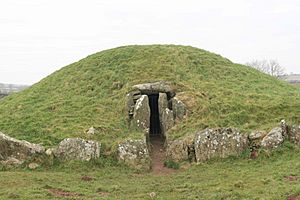Bryn Celli Ddu facts for kids
Bryn Celli Ddu is a very old, prehistoric site on the Welsh island of Anglesey. It is located near a village called Llanddaniel Fab. Its name in Welsh means 'the mound in the dark grove'. People explored the site in 1699, and archaeologists dug there in 1928 and 1929.
Contents
What is Bryn Celli Ddu?
Bryn Celli Ddu is a special place from ancient times. It shows us how people lived thousands of years ago. It has two main parts: an old stone circle and a burial chamber. These structures were built at different times.
The Stone Circle and Henge
Long, long ago, during the Neolithic period (the New Stone Age), a stone circle stood here. There was also a large circular ditch called a henge. The stone circle had 14 stones. The henge was about 30 meters wide. Its ditch was about 5 meters across and 2 meters deep.
People probably used a path or bridge to cross the ditch. This path led into the center of the henge. Archaeologists found a tiny human ear bone there. It was covered by a flat stone in an area of burnt material. The ditch showed signs of being used for a very long time.
The Stone Circle Changes
Later, in the early Bronze Age, the stone circle was taken down. Five of the stones were removed from the site. Two stones were pushed over, and six were broken into pieces. One stone was even buried in the ground.
The Passage Tomb
After the stone circle was removed, a passage grave was built. This tomb was placed right in the middle of the henge. A passage is a long, narrow entrance. This passage is about 8.5 meters long and 1 meter wide.
The main burial room is about 2 meters wide. It was made from six large upright stones. Two big stones covered the top like a roof. Inside the burial room, there was a stone with a twisting, snake-like design. This special stone is now at the National Museum of Wales. A copy of the stone stands outside the tomb today. The earth mound covering the grave was rebuilt after the 1928 dig. The original mound was probably much larger.
Ancient Astronomy and Calendar
In 1906, a person named Norman Lockyer suggested something interesting. He thought that Bryn Celli Ddu was built to mark the summer solstice. The summer solstice is the longest day of the year. At first, people didn't believe him.
But later, in 1997-1998, two researchers, Christopher Knight and Robert Lomas, studied the site. They found that Norman Lockyer was right! They also think the site could have been used as a calendar for farming. More recently, Steve Burrow, an archaeologist at the National Museum of Wales, agreed. He also believes Bryn Celli Ddu lines up with the summer solstice.
This alignment connects Bryn Celli Ddu to other famous ancient sites. These include Maes Howe and Newgrange. Both of those sites point towards the Winter solstice, the shortest day of the year. Some people even think Bryn Celli Ddu might have had a feature like the 'lightbox' at Newgrange. A lightbox lets sunlight shine into the tomb at a specific time.
Older Discoveries
Archaeologists found a row of five postholes at the site. Postholes are holes dug for posts or poles. For a long time, people thought these holes were dug when the tomb was built, around 3000 BC.
However, recent tests using radiocarbon dating show they are much older. Radiocarbon dating helps scientists find the age of old materials. Pine charcoal from two of these pits dates back to the Mesolithic period. This was the Middle Stone Age, even before the Neolithic period.
The Mystery Pillar
Inside the burial chamber, there is a tall stone pillar. Two researchers, Rupert Soskin and Michael Bott, recently had an idea about it. They suggested the pillar might be the petrified remains of a tree trunk. Petrified means it has turned into stone over a very long time.
When you look closely at the pillar, it does look like tree bark. But scientists are still trying to figure out if it really is petrified wood. It could also be a natural rock that the tomb builders chose because it looked so unusual.
Gallery
- Pitts, M. 2006. Sensational new discoveries at Bryn Celli Ddu. British Archaeology No. 89 (July/August): 6.
Images for kids
-
Model of Bryn Celli Ddu in the National Museum of Wales, Cardiff
See also
 In Spanish: Bryn Celli Ddu para niños
In Spanish: Bryn Celli Ddu para niños

















